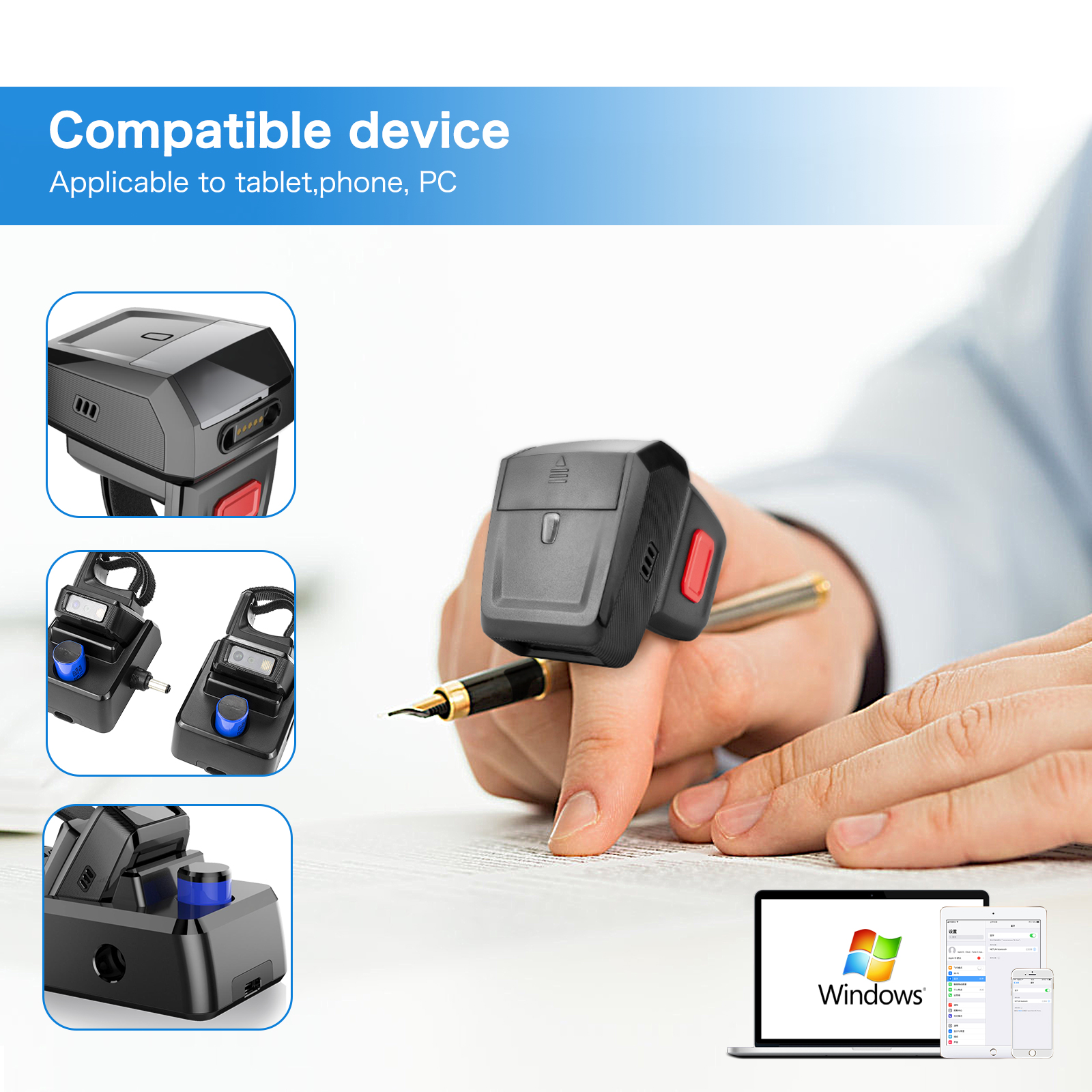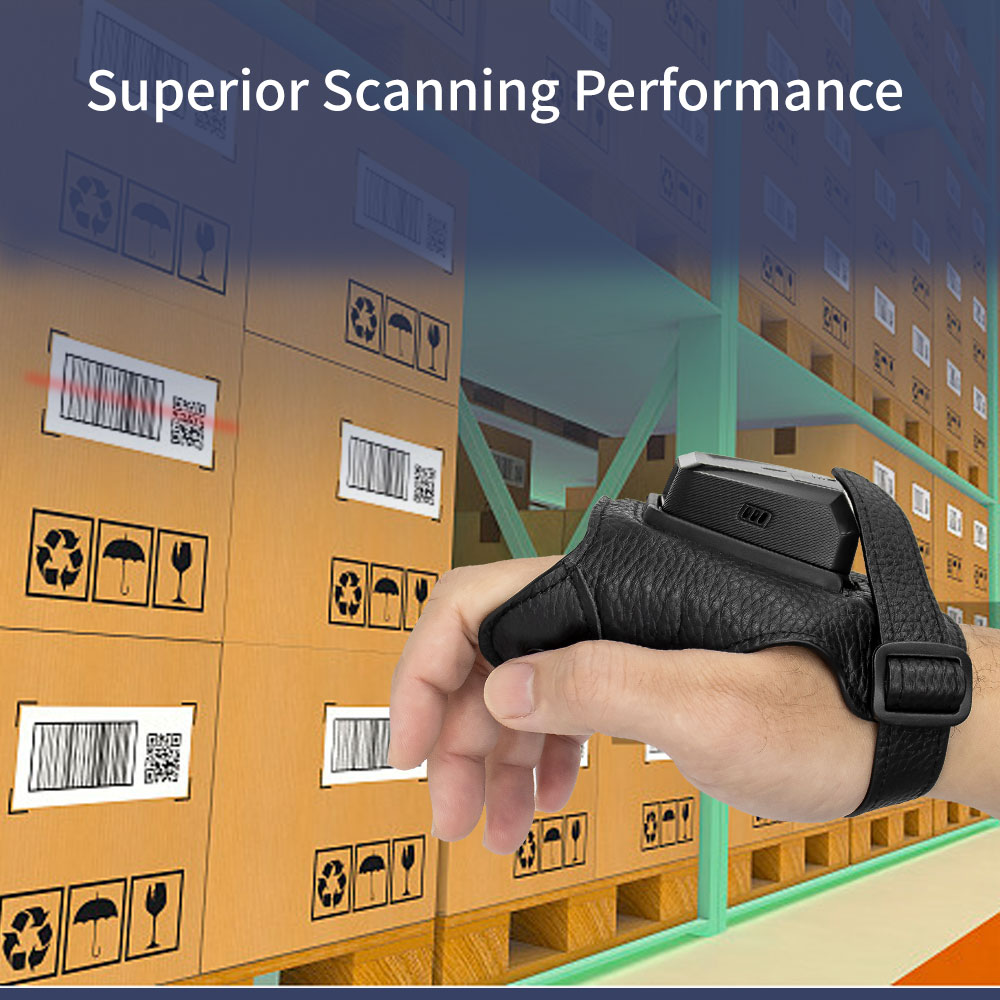With the widespread adoption of barcode recognition technology, hands-free barcode scanners, with their core advantage of "hands-free," have become a key device for improving work efficiency.
1. Wearable hands-free barcode scanners: The Ultimate "Hands-Free" Form"Ring, glove, and wristband" handheld scanners are not standalone categories, but rather highly flexible wearable subcategories of hands-free scanners. Designed with ergonomics as their core principle, these devices deeply integrate scanning functionality with everyday wearable items, making "hands-free work" a reality. Each type of scanner has its own unique features and application scenarios.
Ring hands-free barcode scanners are considered "miniature scanning experts." Measuring only the size of a ring and weighing only 10-30 grams, they are typically worn on the index or middle finger, with the scanning window facing the fingertip. This design allows for seamless hand dexterity, allowing workers to scan items such as picking boxes and merchandise while simultaneously holding them, offering unparalleled convenience. In the picking process of e-commerce or retail warehouses, workers no longer need to frequently switch between holding an item and holding a scanner. Pharmacies can also quickly verify barcodes when sorting medications. Even in jewelry stores, where precision is crucial, it can complete inventory checks without affecting jewelry handling.

Glove-based hands-free scanners offer "two-in-one protection and scanning." The scanning module is cleverly integrated into the index finger or palm of the glove, and the glove is typically made of wear-resistant nylon or non-slip rubber. For logistics loading and unloading operations involving contact with rough objects, or for sorting frozen foods in cold chain warehouses in low-temperature environments, workers no longer need to wear a separate scanner over their protective gloves, ensuring efficient scanning while protecting their hands. They also avoid the inconvenience of direct hand contact during auto parts assembly.

Wristband-based hands-free barcode scanners are more like a "mobile scanning base station." The scanning module is attached to a wristband similar to a watch, with adjustable tension and a rotating scanning window for adjustment. Compared to ring-type scanners, they offer a wider scanning range, covering multiple directions, including in front of and to the sides, and have significantly longer battery life. When sorting shelves in supermarkets, staff can simultaneously scan product barcodes by holding shelf labels. At express delivery outlets, workers can quickly scan shipping labels while holding packages, significantly reducing the number of steps required.
Notably, the core technology of wearable hands-free scanners is the same as that of traditional hands-free scanners, relying on laser or image scanning technology and wireless connectivity. However, the hardware design prioritizes two key aspects: lightweight design to avoid hand fatigue from prolonged wear; and durability, with waterproof and dustproof ratings of IP54 or IP65, making them easily resistant to common warehouse environments like dust and minor water damage.
II. In-Depth Analysis: The Underlying Logic of Technology, Advantages, and Business Value
The advantages of hands-free scanners don't arise out of thin air; rather, they are directly supported by core technology, and these advantages can be translated into quantifiable business benefits. By breaking down the logical chain of "technology - advantages - value," their practical impact becomes clearer. (I) Key Technologies: Core Elements Determining User Experience
The core value of micro-laser or image scanning components lies not only in their size but also in their scanning accuracy. Laser components can accurately read one-dimensional barcodes within 1 cm, such as those found on clear supermarket price tags, resulting in extremely high scanning efficiency. Imaging components (mostly CMOS cameras) excel at handling complex situations, accurately recognizing even wrinkled express delivery labels and tilted QR codes, eliminating repeated operations due to "missing scans" and indirectly improving overall operational efficiency.
Wireless connectivity technologies (Bluetooth and Wi-Fi) overcome spatial limitations. Bluetooth connections typically use version 5.0 or higher, with a transmission range of 10-30 meters, fully meeting the requirements of large spaces like warehouses and supermarkets, freeing workers from the tether of data cables. Wi-Fi connections can directly connect to the enterprise LAN, enabling multiple scanners to simultaneously transmit data to the same inventory system, eliminating the cumbersome and limited wiring required. This is particularly suitable for multi-person collaborative work in large warehouses.
Optimized triggering methods further lower the operational barrier to entry. In addition to traditional physical buttons, some high-end models support "gesture triggers," such as waving a hand near a barcode to automatically initiate scanning. For example, warehouse pickers no longer need to look down to locate and press a button; they simply focus their gaze on the item, and the hands-free barcode scanner completes the scan, effectively reducing neck fatigue and improving operator comfort.
Long-lasting battery life ensures operational continuity. Mainstream hands-free barcode scanners offer 8-12 hours of battery life on a single charge, fully covering warehouse operations from morning to evening shifts. Some hands-free models also support a "1-hour fast charge for 4 hours of use" feature. Even if the battery runs low mid-process, a short charge can quickly restore operation, eliminating workflow interruptions caused by frequent charging.
(II) Core Advantage: Quantifiable Business Value
We often hear figures like "25%-30% increase in efficiency" and "50% reduction in errors." These aren't abstract slogans; they represent real benefits in specific business scenarios.
From the perspective of efficiency improvement, the essence lies in streamlining operational processes. Taking picking in e-commerce warehouses as an example, traditional handheld scanners require four steps: "pick up the item → pick up the scanner → scan → put down the scanner → place the item." Wearable, hands-free scanners, on the other hand, simplify the process to just three: "pick up the item → scan → place the item." This saves only 2-3 seconds per operation, but if 1,000 orders are picked per day, this translates to a cumulative saving of 1-1.5 hours. This is the underlying logic behind the "25%-30% efficiency improvement."
The direct value of reduced error rates is even more significant. In the logistics industry, the error rate for manually entering order numbers is approximately 3%-5%, and a single digit mistyped can result in a package being misdelivered. Hands-free scanners, on the other hand, have an error rate of less than 0.1%. For example, if a courier company ships 10,000 packages daily, reducing the error rate from 5% to 0.1% would eliminate 490 misdelivered packages. Based on a 20 yuan recovery cost per misdirected package (including returns, reshipments, and customer service communications), this saves the company 9,800 yuan per day, truly saving time and money.
Furthermore, the hidden value of safety cannot be ignored. On factory assembly lines, workers holding scanners with one hand can easily cause parts to fall and injure their feet, or the scanner to slip and become damaged. Hands-free barcode scanners allow both hands to hold objects steadily, reducing the risk of dropped items and the likelihood of workplace accidents, indirectly saving the company safety incident handling costs.
III. Key Selection Criteria: Choosing the Right Device in Three Steps
"Ensuring the scanner can read barcodes and is compatible with the device" is the core principle of product selection. Based on actual needs, the selection process can be broken down into three key steps to precisely match the scenario with the device. (1) Determine the barcode type and scanning environment.
The first step is to confirm the basic information of your scanning needs: First, the barcode type. If you only need to scan 1D codes like product price tags, choose a "laser-type" scanner, which is more cost-effective. If you need to scan 2D codes like express delivery labels and electronic payment codes, you must choose an "imager-type" scanner, as it supports both 1D and 2D barcode decoding and is hands-free. Second, the usage environment. For general office or checkout scenarios, a desktop or basic wristband-type scanner with an IP54 dustproof rating is sufficient. For dusty environments like warehouses and logistics, where equipment may fall, choose a wearable (such as a ring or glove-type) hands-free barcode scanner with an IP65 rating or higher, and support 1.5-meter drop resistance. For cold chain and humid environments, focus on "low-temperature compatible" models (operating temperature range -20°C to 50°C), with an IP67-rated waterproof design to protect the device from water damage and low temperatures. (2) Confirm device compatibility and data requirements
The ability of a hands-free barcode scanner to integrate properly with existing systems directly impacts its effectiveness. Regarding interface and connectivity compatibility, if connecting to a POS machine or computer, confirm that the scanner supports either USB wired or Bluetooth wireless connections. If integrating into an enterprise ERP system (such as a warehouse inventory management system), confirm that the scanner supports Wi-Fi or that the brand offers software integration services. Brands like NETUM offer customized integration support to ensure smooth data transmission.
Data transmission requirements also need to be planned in advance. If real-time inventory data synchronization is required, such as when an e-commerce warehouse needs to dynamically update product inventory, choose a model that supports Wi-Fi or Bluetooth real-time transmission. If the hands-free barcode scanner only needs to store data offline, such as in outdoor inventory management scenarios, choose a model with at least 16GB of built-in storage. These devices can store over 100,000 barcode data entries, which can then be exported to the system back indoors.
(3) Combine usage frequency with budget
Differences in usage frequency and budget will determine the device selection. For high-frequency use scenarios, such as 24/7 assembly lines, a "fixed-mount + multi-line laser" scanner should be prioritized. Its fast scanning speed and durability are strong, allowing it to withstand long periods of intense work. For mobile scenarios, such as warehouse picking and on-the-go inventory taking, a "wearable (ring/wristband) + long-life battery" hands-free barcode scanner is the best choice, adapting to frequent mobility.
For budgetary constraints, there's no need to pursue high-end features. Prioritizing the two core requirements of "barcode type + device compatibility" is crucial. Basic desktop or entry-level wristband-style hands-free barcode scanners offer better value. For more complex needs, such as those involving cold chain environments and scanning multiple barcode types, a customized model, such as NETUM's adjustable scanner, can be selected. Its parameters can be adjusted to meet specific needs, maximizing its value.
The value of a hands-free barcode scanner lies in integrating efficiency, accuracy, and convenience into every operational process through technological innovation and application-specific adaptation. Whether it's the wearable's flexible design or the deep integration of technology and advantages, the ultimate goal is to "improve business efficiency and reduce costs." Only by understanding the key selection criteria and choosing the device that suits your needs can a hands-free barcode scanner truly become a business growth booster.

